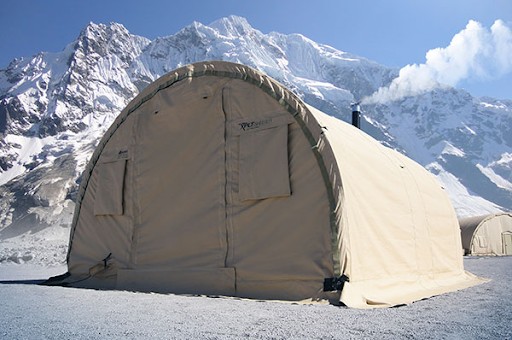Maintaining Operational Readiness with Cold-Weather Military Tents
- October 14, 2024
- Category: Alaska Defense Applications, Turnkey Facilities

Military forces have always had to contend with the cold. When temperatures drop, cold weather becomes a second enemy for troops to deal with.
Extreme and hazardous cold adversely affects the capability of a unit to accomplish its mission. Understanding the impacts of a cold environment can assist a unit in countering these effects.
Today’s military can more aptly maintain a state of readiness against new and emerging threats in cold climates by utilizing modern cold-weather military tents.
Defeating the Cold Through Military Tent Advancements
Military tents were the most common shelter system for officers and troops during both the Revolutionary and Civil War. Revolutionary War soldiers typically used a material called “duck,” which was made from cotton or hemp. Through the decades, military tent design and materials continued to develop.
Today’s advanced military tents are manufactured using high-tech composites and lightweight metals. These specialized components allow 21st-century military shelters that can be set up in less than 10 minutes and protect soldiers and equipment from extreme weather conditions.
Offering many benefits over other commercial-off-the-shelf (COTS) shelter systems, modern military tents are aligned to support any military objective to build or maintain operational readiness, including proprietary insulation and military HVAC systems, plug-and-play lighting, and electrical systems, power generation and distribution systems, and more.
In addition to providing cold-weather tents to soldiers, some military forces offer cold-weather training with a Cold-Weather Operations Course (CWOC) in which hundreds of soldiers, Sailors, Marines, Airmen, and others learn many cold-weather skills. Among the most important of those skills is being able to create shelter in a cold-weather environment.
Keeping Vehicles, Aircraft, and Equipment from Freezing
The 402nd Army Field Support Battalion-Alaska (AFSBn-ALK) recently spent a month testing the systems and equipment used in an extreme arctic environment. Known as Arctic Warrior 21, this innovative training exercise is designed to affirm the battalion’s ability to rapidly deploy and operate in sub-zero temperatures. Temperatures at the training area reached as low as negative 30 degrees Fahrenheit throughout the exercise.
Keeping military vehicles above freezing is crucial to the protection of mission-critical readiness. In addition to vehicle storage and maintenance facilities, environmental control units and insulation are used to keep vehicle components from freezing and keep staff and equipment safe from the elements.
For example, vehicle components can become frail in the cold and potentially break. This happens at temperatures below minus 20 degrees Fahrenheit for rubber and synthetic rubber materials. As a result, troops may not have a usable vehicle if temperatures drop sufficiently, jeopardizing their operational readiness.
Batteries are another important consideration, as their available energy is significantly reduced as temperatures drop. It might not even be possible to create a current large enough to start the vehicle in extremely cold temperatures. Batteries may even break if they completely freeze, after which they can leak dangerous chemicals as they thaw.
Prepare for the Cold with Military Tents
Military forces must keep both themselves and their equipment safe and prepared in the face of cold environments. With advanced cold-weather military tents, militaries have an ally they can count on to support their operational readiness.
Alaska Defense® (Alaska), formerly the Military Division of Alaska Structures, Inc., provides the highest-quality cold-weather military tents for use as billeting and housing facilities, vehicle storage facilities, as well as large-area maintenance shelters (LAMS) for vehicle maintenance (LAMS-VM) and aircraft maintenance (LAMS-AM).
All our cold-weather military tents provide:
- Durability in the face of harsh weather conditions: Alaska Defense’s cold-weather military tents are engineered to meet the specific snow and wind loads for safety. Our use of strict control processes, the latest manufacturing techniques, and the highest-quality materials ensures that every cold-weather military tent will endure 100 repeated setup and strike cycles — even in the harshest of climates.
- Temperature controls: Keep troop housing facilities and vehicle storage facilities above freezing with the Alaska ECU®, which seamlessly integrates with any Alaska Defense military tent. Our proprietary insulation system, EnerLayer®, can supplement the Alaska ECU for even greater energy savings.
- Plug-and-play lighting and electrical systems: Our lighting and electrical systems are available in 50 and 60 Hz configurations, making it easy to provide lighting and power in military tents used around the world. Alaska Defense also manufactures power generation and distribution systems capable of sharing a single power source for multiple shelters.
Military tents that are going to be used for vehicle and aircraft storage, or as cold-weather maintenance facilities can also be equipped with a vehicle exhaust system to safely exhaust any vehicle fumes.
What’s more, our cold-weather military tents drastically reduce the logistics involved with transporting, can be installed on virtually any level surface, are fast to set up, and offer an unmatched strike capability when mission objectives change.
Email us or complete our inquiry form to discuss using cold-weather military tents to support new or existing military operations.